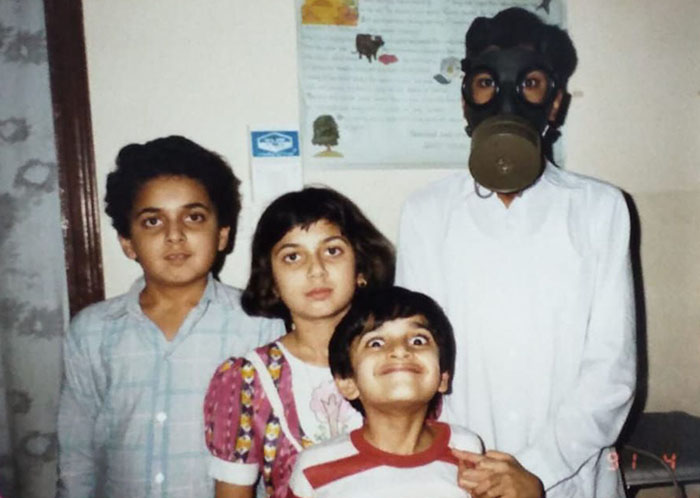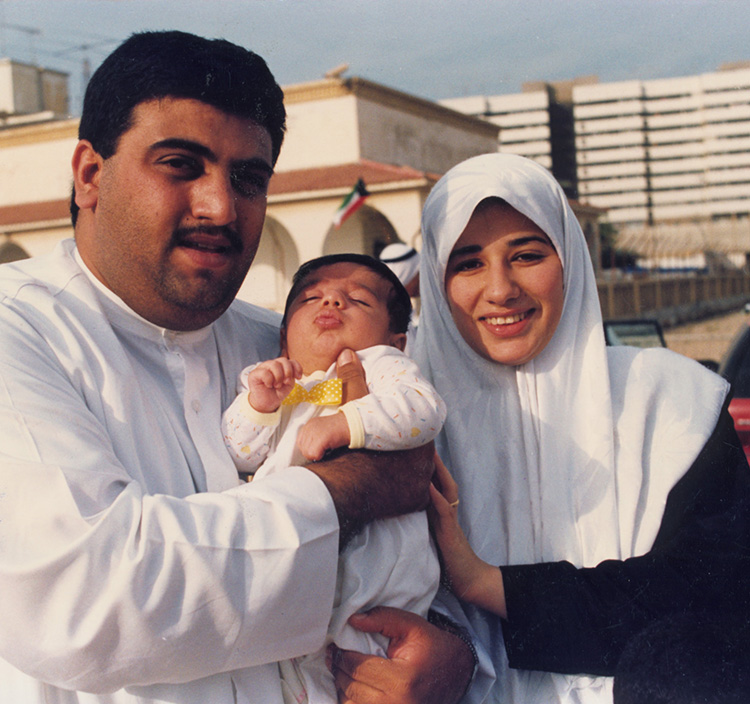
The author sports a gas mask in Riyadh in 1990 in this screen-grab from a family VHS tape.
VIEW FROM SAUDI ARABIA:
‘I NEVER THOUGHT I’D OWN
A GAS MASK’
‘It was not uncommon to hear unmistakable sound of Scuds flying above our home’
Dubai: August 2, 1990 as an unforgettable day in my life. I was a nine-year-old living in Riyadh, Saudi Arabia and that morning over breakfast, my father, who was a reporter for Arab News, broke the news to me that Iraq had invaded and occupied Kuwait. He seemed worried that the war would spill over into Saudi Arabia. I still remember the excitement and fear of the unknown. I was excited thinking we were going to witness a historical event and scared because just a week earlier, our history teacher had taught us about World War II.
I somehow thought events would be as devastating as World War II. For the next few weeks, this was the hottest topic of discussion at home. Many of the families we knew suddenly started flying back to their home countries. Fearing the worse, we began preparing for it. An emergency suitcase was packed just in case we needed to leave our home at short notice. All family members were informed about its location. It was packed with a week’s worth of requirements, along with some medicines, instant food, jewellery and some cash. The gaps near the windows and ACs at home were sealed, as a chemical attack was anticipated in case war broke out. We were told to put sticking tape diagonally across the windows to prevent them from shattering.
Apparently, Iraq had stockpiles of two types of chemical gases - the mustard gas and the lewisite gas. Mustard gas is heavier than lewisite. We were instructed to coordinate with our neighbours and move to the upper floor in the event of a mustard gas attack or to the lower floor if lewisite gas was used. Our cartoon channel, Saudi 2, was replaced with news update on the war 24x7. I remember being more shocked learning about this than the news of the invasion! The TV station was a major time pass for us four siblings.
We purchased six gas masks worth SR600. It was the most adventurous thing I had ever seen. Never in my life had I though I would own a gas mask of all things! It came with a set of instructions, which were relatively easy to follow. One way of ensuring you had worn it right was to place your hand over the opening where the oxygen tank would fit. The key was not being able to breathe when the opening was covered. I remember enacting a war and these masks came in very handy. (And the other time it came in handy was when one of my brothers and I were afflicted with chicken pox. My eldest brother, who was healthy, used the mask when interacting with us!)
Our school normally had a separate campus for boys and girls at different locations. But for this period, both boys and girls were taught in one building. Many students and faculties went back home. We had strict instructions to carry our gas masks to school daily. The students used to flaunt their masks and I noticed everyone had a different mask. I never showed my mask to them as I thought it was the most boring in design in class. There were many rehearsals for a potential attack. I remember a siren would go off at different times of the day as part of the rehearsals,and we were told that at that time all the lights must be switched off and nobody should stand near the window. And if it was a chemical attack, a wet piece of cloth must be used to cover the face. Someone we knew once mistook the siren drill for a real attack, and covered her sick child with a drenched blanket!

Rufaida with her brothers at their home in Riyadh, 1990.
Our house was near the Ministry of Interior, and when war broke out, it was not uncommon to hear the unmistakable sound of Scud missiles flying above us. I could literally feel the vibrations in my heart. At that time we would all start praying. Once, a missile landed in an area not far from our place and, to this day, it is the loudest, most fearsome sound I have ever heard. The vibrations passed a tingle down my spine. Many of our windows cracked from the blast waves. There were unused residential towers near the Ministry of Interior, which were opened up for the fleeing Kuwaitis. These buildings came to be known as the ‘Kuwaiti Quarters’.
At a press conference, my father was given complimentary food samples of what the US soldiers ate in war zones. They were called MREs (meals ready to eat). The pack came in sealed brown pouches. When the seal is broken, a thermal reaction takes place and the heat thus generated warms the food inside. We got to sample meatballs with veggies, which were quite tasty. After the war ended in February 1991, we visited the port city of Dammam for a short holiday and were astonished to see thick black smoke covering the entire sky - from the oil wells in Kuwait that had been set alight by angry, retreating Iraqi soldiers. The scene was so intense that much of the sun appeared as the moon. It was a sight to behold. And there were miles upon miles of US tanks, waiting to board the ship for their long journey home.
